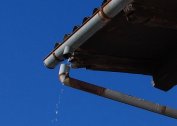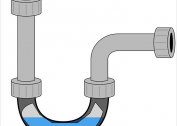The difference between the external and internal sewage systems is obvious. The first includes all pipelines inside the building. The second network is laid outside the building and connected to the treatment plant or the central city system. For each sewer complex, polymer pipes with suitable technical characteristics are selected. Externally, they differ in color.
Features of gray pipes
I use gray pipelines made of polymeric materials in domestic sewers. It is laid along the contour of the house and discharges the drain fluid, together with fatty inclusions and household chemical residues, to the external system, and then to the centralized citywide network or local treatment facility.
Pipes of a grayish shade used during installation inside the house are inferior to red ones in strength. Their walls are 2.7 mm thick, but the temperature maximum is 95 degrees.
Typically, products with a cross section of 50 and 110 mm are made, which allows laying sewer lines from any sanitary and household appliances.
Pipelines of this type are fireproof and not susceptible to corrosion. But they are not tough enough to lay them under the ground. When installed outside the house, the mains can burst under frozen ground. However, they cope well with the loads that arise during operation inside the building. Such pipes are mounted with a slope to the walls.
Technical characteristics of red pipes
For such products, the walls consist of several layers, so they are much stronger than gray analogues. The depth of the sewage laying depends on the wall density indicator. Pipelines of class SN4 have a density of 3 mm and are allowed for installation at a depth of 0.8–6 m from the surface. Class SN8 with walls of 3.2 mm can be laid to a depth of more than 6 m. This option can be installed under busy traffic arteries.
Most often, brick-colored pipes are produced in diameters of 110 and 160 mm.
Mounts of red color in the direction of drains. They are also not susceptible to chemicals and other destructive processes associated with corrosion. But under the influence of low temperatures, even strong plastic products become fragile, so they are installed with extreme caution in the cold.
If greater strength is required, corrugated orange pipes should be selected. Due to the waviness, such products have a larger external surface area, as a result of which the load created by the soil is redistributed. This means that the red corrugated pipe will withstand the greatest pressure.
Manufacturers offer two types of corrugated pipes:
- Having only one layer. Ribbing here goes both inside and out. Products are cheaper, can be made of PVC in different colors. Their disadvantage is that due to the lack of smoothness of the inner surface, they quickly become clogged. Their throughput is also lower than that of the two-layer version.
- Consisting of two layers. Inside, they are smooth, usually gray-white, and outside - corrugated and reddish. Due to the different structure of the layers, a minimum of resistance to the flow of the drain fluid is provided.
Manufacturers guarantee that the life of the red sewer pipelines is not less than half a century. In practice, this period is doubled.
The disadvantages of orange highways are their high price.It is explainable by increased performance due to the special structure of the products.
Assignment of pipes of a different color
Sewer lines may not necessarily be tan or gray. There are pipes of other shades:
- Green pipelines for sewers. They are usually used to create subsoil drainage systems. Products of this color are durable, not afraid of corrosion and resistant to temperature changes. They are most often perforated so that water can easily enter drains.
- White sewer pipes. This is the rarest option. In all respects, they practically do not differ from their grayish counterparts and are used to discharge drains inside the house. White color is given to them for decorative and aesthetic functions, if it is impossible to hide the sewer nodes. Gray pipes stand out against the background of the walls and visually spoil the interior of the bathroom.
- Black options. They are also quite rare. They are made of high pressure polyethylene. Black products are used for laying highways both inside and outside the building. But they, despite their durability, do not tolerate serious temperature extremes. They can not withstand excessive loads, so laying under the motorways is impossible.
Black pipes are usually used to protect communication cables or to equip drainage systems. The latter are easy to distinguish by the presence of holes in the walls, allowing moisture to enter the network.
Not only pipe segments, but also connecting fittings differ in color. They must be selected in the same shade as the main pipeline. This will avoid possible leaks due to pressure drops and maintain a holistic appearance of the system.
The main differences
The main difference between grayish and brick pipes is resistance to external influences. Both of them easily withstand a one-time discharge of high temperature water. But if the hot runoff goes constantly, the gray options will increase in size, which will lead to deformation.
 Gray sewer pipes differ from red ones in other parameters:
Gray sewer pipes differ from red ones in other parameters:
- Thermal conductivity. In grayish products, it is higher. Layers of brick-colored PVC have a porous structure, which reduces their ability to transfer heat.
- The ability to create a large number of branches and connections. Gray products also lead here. Using them, you can create sewer lines of almost any configuration.
- Soundproofed. Pipelines made of gray-colored polymers drown out the sounds of water, which is important when laying them inside the building. There are options with an additional layer of wall for sound absorption, but their cost is slightly higher than usual.
- Pressure from transport routes. If laying under the highway, only orange pipes can be used. But even it is desirable to protect them with metal sleeves.
- Cost. Red products are almost twice as expensive as gray ones.
The difference between the pipelines is easy to determine in practice. An adult cannot walk through pipes of gray shade. The product immediately deforms. Orange can withstand a similar experiment without consequences. However, if only gray items are available, they can be placed in sleeves. So the integrity of the pipes under soil loads will not suffer.
This is not to say which sewer pipes are better: gray or orange - they differ in purpose. Each option is good in its place. Incorrectly selected shade material for the highway can cause a decrease in efficiency, a deterioration in the efficiency of the sewage system. If you correctly calculate all the conditions for placing the pipeline, you can do without unnecessary costs.







